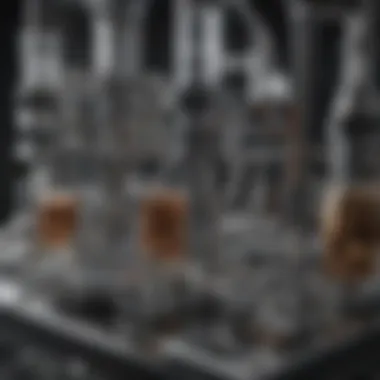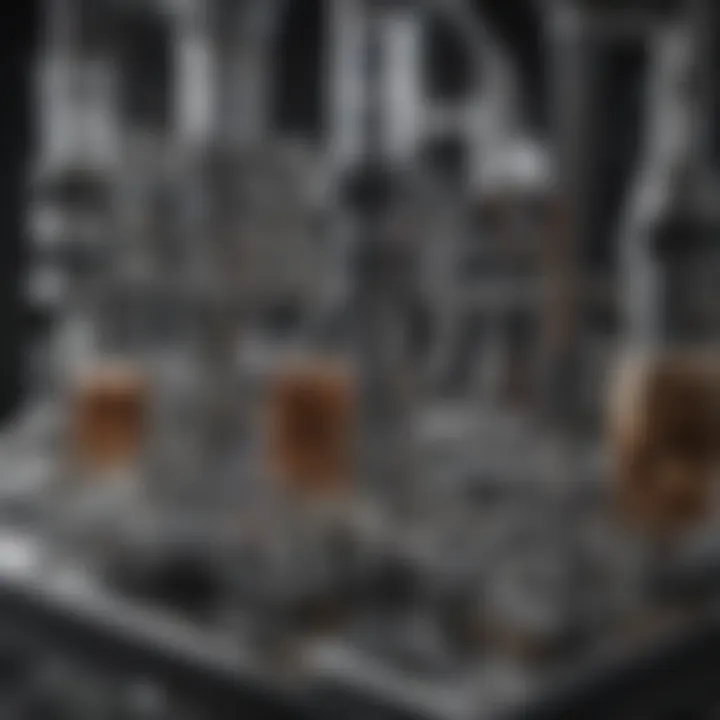Innovative Secretome Analysis via Mass Spectrometry


Intro
Secretome analysis has gained significant traction in the realms of biological and medical research, particularly through the use of mass spectrometry. This approach enables researchers to identify and quantify proteins secreted by cells into their environment. The secretome is not merely a collection of proteins; it plays a crucial role in cellular communication and can provide insights into disease mechanisms. Mass spectrometry offers a powerful platform to explore the secretome, providing high sensitivity and specificity for protein detection. As we move forward, understanding the methodologies, applications, and future prospects of secretome analysis is paramount for advancements in both therapeutic and diagnostic fields.
Research Overview
Summary of Key Findings
Recent studies highlight key methodologies used in secretome analysis through mass spectrometry. These studies have demonstrated that various mass spectrometry techniques, such as liquid chromatography-tandem mass spectrometry (LC-MS/MS), are particularly effective in profiling secreted proteins.
Key findings include:
- Identification of biomarkers: Secretome profiling has emerged as a promising strategy for discovering biomarkers associated with various diseases, including cancer and neurodegenerative disorders.
- Therapeutic insights: Analysis of the secretome contributes to understanding how cells communicate under different conditions, which is essential for identifying potential therapeutic targets.
Relevance to Current Scientific Discussions
The increasing complexity of biological systems necessitates accurate and comprehensive tools to study protein interactions and functions. The secretome represents an interface between cells and their extracellular environment, showcasing its importance in both normal physiology and pathological states.
Researchers are addressing questions such as:
- How do changes in the secretome relate to disease progression?
- What role does the secretome play in intercellular signaling?
Such inquiries are central to current discussions in proteomics and cellular biology, intensifying the focus on mass spectrometry as a pivotal tool in secretome analysis.
Methodology
Research Design and Approach
In studying the secretome via mass spectrometry, the research is often designed around isolating the proteins secreted by cells in controlled environments. Cell cultures are frequently used to study specific physiological or pathological conditions, which enables the collection of secreted proteins.
Data Collection and Analysis Techniques
The techniques employed for data collection primarily revolve around mass spectrometry methods:
- Sample Preparation: Adequate preparation is critical. Techniques may involve centrifugation and protein precipitation to enrich the secreted proteins.
- Mass Spectrometry Techniques: The adoption of methods such as LC-MS/MS allows for detailed analysis of complex mixtures. This technique must be complemented with advanced data processing tools for accurate quantification and identification of proteins.
By engaging in a robust methodology, this research aims to illuminate the vast potential of secretome analysis. It paves the way for informed discussions on future directions in biomarker discovery and therapeutic development.
Preamble to Secretome Analysis
Secretome analysis is a pivotal area of research within proteomics, focusing on the collection and study of proteins secreted by cells. These proteins, known as the secretome, provide valuable insights into cellular behavior and interactions in various biological contexts. Understanding the secretome is essential for multiple reasons. It aids in identifying biomarkers, elucidating disease mechanisms, and developing therapeutic strategies. The article explores the significance of secretome analysis through mass spectrometry, a powerful tool for protein characterization.
We will cover fundamental aspects, including definitions, the importance of the secretome, mass spectrometry techniques, methods for extraction, and applications in medical research. Each section aims to build a coherent framework that illustrates how secretome analysis contributes to advancing our understanding of biology and medicine.
Defining the Secretome
The secretome refers to the entire array of proteins secreted by cells into their surrounding environment, including the extracellular space and bodily fluids. This group of proteins encompasses signaling molecules, enzymes, growth factors, and extracellular matrix components. The secretome can be influenced by various factors such as cell type, physiological conditions, and external stimuli.
Examining the secretome allows researchers to understand not just what proteins are produced, but also how they interact with other cells and respond to changes in the environment. It serves as a mirror reflecting cellular status and can reveal how cells communicate and collaborate in tissue regeneration, immune response, and disease progression.
Importance of Secretome in Biological Systems
The secretome plays a significant role in numerous biological processes. One crucial aspect is its involvement in intercellular communication, which is vital for maintaining homeostasis. The proteins within the secretome facilitate signaling pathways that regulate cell growth, differentiation, and repair.
Moreover, the secretome is intimately linked to disease. Alterations in the composition of secreted proteins can signal the presence of pathological conditions such as cancer, inflammation, and neurodegenerative diseases. For instance, specific biomarkers derived from the secretome may indicate the early stages of disease, enabling timely intervention.
"Understanding the secretome is essential for biologists and medical researchers as it provides a window into cellular communication and pathology."


Fundamentals of Mass Spectrometry
Mass spectrometry is a pivotal technique in secretome analysis. It offers powerful capabilities for detecting and quantifying proteins and peptides in a biological sample. Understanding the fundamentals of mass spectrometry is essential for researchers in proteomics, as it provides the basis for exploring the secretome's complexities.
Principles of Mass Spectrometry
Mass spectrometry operates on the principle of measuring the mass-to-charge ratio of ions. This is achieved by converting molecules into ions and then manipulating these ions using electric and magnetic fields. The process generally involves three main stages: ionization, transport, and detection.
- Ionization: Here, the target molecules are converted into charged particles. This can happen through various methods, depending on the specific technique implemented.
- Transport: Ions are then moved through a vacuum to minimize interaction with air, which could interfere with their trajectories.
- Detection: Finally, ions hit a detector, where their mass and abundance are measured. The resulting data are then processed to yield information about the molecular composition of the sample.
These principles contribute significantly to the workflow in secretome studies, enabling high-throughput analysis of proteins that are released by cells into their surrounding environment.
Different Types of Mass Spectrometry Techniques
Numerous mass spectrometry techniques exist, each tailored for specific applications in secretome analysis. The choice of technique can affect the sensitivity, resolution, and accuracy of the results. The most prominent techniques include:
Electrospray Ionization (ESI)
Electrospray Ionization is a soft ionization technique that allows for the analysis of biomolecules without significant fragmentation.
- Key Characteristic: Its ability to produce ions in solution makes it ideal for analyzing large biomolecules such as proteins.
- Benefits: ESI is beneficial in complex sample mixtures common in secretome analysis.
- Unique Feature: The technique produces multiply charged ions, making it easier to analyze large proteins and peptides within a manageable mass range.
- Advantages/Disadvantages: While ESI offers high sensitivity and the ability to handle complex samples, it requires a stable and homogeneous solution, as variations can lead to inconsistent results.
MALDI-TOF
Matrix-Assisted Laser Desorption/Ionization Time-of-Flight (MALDI-TOF) is another significant technique. It utilizes a laser to ionize samples that are embedded in a matrix.
- Key Characteristic: Its rapid analysis time for large numbers of samples is a standout feature.
- Benefits: MALDI-TOF is particularly helpful in identifying proteins and other biomolecules quickly.
- Unique Feature: The method can accommodate a wide range of sizes and types of biomolecules, which is crucial for comprehensive secretome profiling.
- Advantages/Disadvantages: While MALDI-TOF is effective for large-scale analyses, it may suffer from background noise issues, potentially complicating data interpretation.
Triple Quadrupole Mass Spectrometry
Triple Quadrupole Mass Spectrometry (TQMS) provides additional selectivity and sensitivity, which is crucial for quantification in secretome studies.
- Key Characteristic: TQMS enables multiple reaction monitoring (MRM), allowing researchers to quantify specific analytes amid complex mixtures.
- Benefits: This technique is robust in detecting low abundance proteins, a common concern in secretome analysis.
- Unique Feature: The series of three quadrupoles enhances the specificity of the mass analysis, providing cleaner data.
- Advantages/Disadvantages: Although TQMS offers enhanced sensitivity and accuracy, it is a more complex setup, requiring precise optimization and calibration to yield optimal results.
The selection of a mass spectrometry technique plays a crucial role in the successful analysis of the secretome, impacting not only the sensitivity and specificity of the results but also the overall understanding of the biological contexts in which these proteins function.
Methods of Secretome Extraction
The methods of secretome extraction play a critical role in the analysis of biomolecules released by cells. These secreted proteins and factors are pivotal in understanding various biological processes and disease mechanisms. Hence, choosing the right extraction techniques is essential. The effectiveness and efficiency of these methods can influence the quantity and quality of analytes obtained for subsequent mass spectrometry analysis. Therefore, researchers must consider specific elements like cell type, the nature of the secretome, and the intended applications when selecting techniques.
Under this heading, we will comprehend the significance of two prominent methods: cell culture techniques and protein precipitation and isolation. Each method provides unique advantages and has specific considerations that must be weighed carefully during the design of research studies.
Cell Culture Techniques
Cell culture techniques are fundamental for extracting the secretome because they simulate physiological conditions. Culturing cells in controlled environments allows for the study of various conditions over time, leading to the collection of secreted factors. Different cell lines can be used depending on the research focus, such as fibroblasts or cancer cell lines.
When utilizing these techniques, researchers often focus on the following aspects:
- Optimizing growth conditions: Factors like nutrient media, temperature, and incubation times can dramatically affect secretome profiles.
- Avoiding contamination: Maintaining sterile conditions is crucial to prevent unwanted interference that could skew data.
- Harvesting secretome samples: Timing is important when collecting supernatants, as different phases of cell growth yield varying secretome compositions.
"Effective cell culture techniques are vital for obtaining a representative secretome sample."
The advantages of employing cell culture techniques lie in their reproducibility and ability to control specific experimental parameters. However, such approaches also have limitations including the possible deviation from in vivo conditions and the influence of the culture environment on cellular behavior.
Protein Precipitation and Isolation
Protein precipitation and isolation methods serve to purify the secretome from various contaminants. These techniques are necessary after the initial extraction to ensure that the protein samples are suitable for mass spectrometry analysis. Different protocols exist, and the choice depends on the specific context and requirements of the study.
Here are some common approaches used:


- Salting out: Involves adding salts that cause proteins to precipitate out of solution.
- Organic solvent precipitation: Using ethanol or acetone helps to concentrate proteins in the sample.
- Affinity precipitation: Specific antibodies can be used to selectively isolate proteins of interest.
These methods can improve the quality of the samples significantly. Moreover, they aid in concentrating proteins and reducing the volume of the sample. While protein precipitation methods are beneficial, they also introduce challenges such as potential protein loss or co-precipitation of unwanted substances.
In summary, understanding methods of secretome extraction is essential for successful secretome analysis by mass spectrometry. Careful consideration of cell culture techniques and effective protein precipitation will ensure high-quality samples for downstream applications.
Techniques in Secretome Analysis
The analysis of the secretome represents a pivotal aspect of proteomics. The techniques employed to analyze secretome provide insights that drive our understanding of cellular functions and disease mechanisms. These methods allow for the identification and quantification of proteins released by cells, facilitating the discovery of biomarkers and therapeutic targets. Thus, mastering these techniques is essential for researchers aiming to harness the full potential of secretome analysis.
Mass Spectrometry Protocols for Secretome Analysis
Mass spectrometry serves as the backbone of secretome analysis. Its sensitivity and specificity enable the detection of a wide range of proteins at low concentrations. The protocols in mass spectrometry vary according to specific objectives, but they generally follow several core steps:
- Sample Preparation: Samples from cultured cells or biological fluids undergo processing to isolate the secreted proteins. This step often includes filtration, concentration, and sometimes precipitation to enhance the quality of the samples.
- Ionization: Techniques like Electrospray Ionization (ESI) or Matrix-Assisted Laser Desorption/Ionization (MALDI) are used to convert proteins into ions. These methods differ in terms of compatibility with complex mixtures and sample types.
- Mass Analysis: Ions are analyzed based on their mass-to-charge ratio. The choice of mass analyzer, such as a time-of-flight (TOF) or a quadrupole system, affects the resolution and accuracy of the measurements.
- Data Interpretation: The acquired mass spectra are analyzed using software designed for protein identification and quantification. Here, the challenge lies in distinguishing true signals from noise, as well as in interpreting the resulting data effectively.
Data Analysis in Mass Spectrometry
Data analysis in mass spectrometry is critical for extracting meaningful insights from the generated data. This process typically splits into two components: quantification methods and statistical approaches. Both contribute significantly to the reliability of the results.
Quantification Methods
Quantification methods are essential because they determine how much of each protein is present in the sample. The most utilized methods include label-free quantification and isobaric tagging methods.
- Label-Free Quantification: This method, which relies on comparing ion intensity across different samples, is favored for its simplicity and minimal sample requirement. A key characteristic involves relative quantitation, making it easier to compare different conditions.
- Isobaric Tagging: Techniques such as TMT (Tandem Mass Tags) enable simultaneous quantification of multiple samples. This unique feature allows researchers to analyze several conditions in a single run, though it introduces complexity in data analysis. The major disadvantage lies in the higher costs and the need for more intricate protocols.
In sum, the choice of quantification method heavily relies on experimental goals and resource accessibility.
Statistical Approaches
Statistical approaches are indispensable in interpreting the mass spectrometry data accurately. They provide frameworks to handle biological variability and enhance confidence in the results. Common statistical methods used include:
- t-tests and ANOVA: These tests help to determine if there are significant differences in protein abundance between groups, which is fundamental in biomarker studies.
- Multivariate Analysis: Techniques such as PCA (Principal Component Analysis) allow for the exploration of data patterns. This characteristic aids in visualizing complex data sets, showcasing variability among samples effectively.
The main advantage of robust statistical methodologies is their ability to account for variability in biological systems. However, the reliance on proper assumptions and interpretation can complicate the analysis.
Applications of Secretome Analysis
Secretome analysis has gained traction in various research domains due to its ability to reveal insights about cellular communication and the extracellular environment. This subsection will explore some key elements that highlight the significance of secretome analysis in contemporary biological research.
The secretome encompasses proteins and metabolites released by cells, providing a snapshot of cellular activity and interaction. One of the primary benefits of analyzing the secretome is its potential role in identifying biomarkers for diseases. By comparing the secretome of healthy and diseased cells, researchers can discover specific proteins or molecules that indicate the presence or progression of various conditions. This approach is particularly valuable in early diagnosis and monitoring of diseases, such as cancer, where timely intervention can significantly improve patient outcomes.
Moreover, secretome profiling contributes to therapeutic insights. Analyzing how cells respond to treatments or environmental changes can uncover mechanisms of action for drugs, providing crucial information for the development of more effective therapies. For instance, understanding which proteins are secreted in response to a therapy can help tailor treatments to improve their efficacy and reduce side effects. This personalized medicine approach has the potential to revolutionize patient care by leveraging the unique profiles of individual secretomes.
Additionally, the role of secretome analysis in cancer research cannot be overstated. Tumor microenvironments release unique secretomes that contribute to tumor growth, metastasis, and resistance to therapy. By studying these secretomes, researchers can identify pathways and interactions that promote cancer progression, leading to the development of targeted therapeutic strategies. Furthermore, as cancer biology becomes increasingly complex, integrating secretome data with other omics approaches can offer a more comprehensive understanding of tumor biology and create opportunities for innovative treatment options.
"The study of the secretome offers a unique lens through which to understand cellular interactions and their implications in health and disease."
In summary, the applications of secretome analysis are vast, spanning from biomarker discovery to therapeutic insights and cancer research. As this field advances, the integration of advanced technologies, such as mass spectrometry, will play a crucial role in elucidating the complexities of the secretome, ultimately enhancing our capability to address various health challenges.
Challenges in Secretome Analysis
The field of secretome analysis presents unique obstacles that can hinder the accurate characterization and application of secreted proteins. Understanding these challenges is crucial for researchers aiming to leverage secretome data in biological and clinical contexts. Failure to address these issues may lead to misleading conclusions or ineffective therapeutic strategies. It is essential to recognize how technical limitations and biological variability can affect study outcomes and interpretations.
Technical Limitations
Mass spectrometry, while a powerful tool, comes with inherent technical limitations that can complicate secretome analysis. One significant challenge is sensitivity. The secretome consists of proteins present in varying concentrations, with some being exceedingly low. Detecting these low-abundance proteins often requires refined methods, such as enrichment processes that can inadvertently alter or remove proteins of interest. Despite advancements in mass spectrometry technologies, achieving sufficient sensitivity remains a critical concern.
Another issue is the dynamic range of detection. The wide diversity in protein concentrations within the secretome can pose challenges for quantitative analysis. High-abundance proteins may mask the presence of low-abundance ones, leading to incomplete profiles. Techniques like label-free quantification and stable isotope labeling offer solutions, but they too have limitations concerning accuracy and reproducibility.


Instrumentation variability also impacts results. Different mass spectrometry platforms may provide varied data, making cross-comparisons difficult. Furthermore, the variability in operator skill and experience can affect protocol adherence, introducing variability into the findings.
Biological Variability
Biological variability adds another layer of complexity to secretome analysis. The secretome can change dramatically depending on numerous factors, including cell type, growth conditions, and physiological states. For instance, the secreted proteins of healthy cells will differ significantly from those of diseased cells. This variability must be considered when designing experiments and interpreting results.
Another factor is inter-individual differences. Proteins secreted from cells can exhibit variability across individuals due to genetic differences, dietary habits, and other external influences. This variability complicates biomarker discovery efforts since a biomarker identified in one population may not be applicable in another.
Furthermore, temporal changes in secreted proteins need consideration. The secretome is dynamic, evolving in response to environmental changes or cellular stressors. This can lead to different proteomic signatures over time, making it challenging to establish a standard reference for comparisons.
"Addressing both technical limitations and biological variability is crucial. This can enhance the reliability of secretome analysis, leading to better insights in the field of proteomics."
Future Directions in Secretome Research
Future directions in secretome research play a pivotal role in enhancing our understanding of cellular dynamics and disease mechanisms. The secretome, consisting of secreted proteins and other macromolecules, provides critical insights into intercellular communication and the biology of various conditions. The exploration of its intricacies not only enhances our knowledge but also expands the potential for breakthroughs in diagnostics and therapeutics.
Innovations in Mass Spectrometry Technology
Innovations in mass spectrometry technology are fundamental to the progression of secretome research. As the field continues to evolve, new technologies are being developed that refine the sensitivity and specificity of detection methods. For instance, improvements in high-resolution mass spectrometry have allowed for the identification of low-abundance proteins in complex mixtures. This is particularly important in secretome analysis, as many secreted molecules exist in trace amounts.
Moreover, advancements in tandem mass spectrometry (MS/MS) facilitate better fragmentation patterns, leading to more accurate protein identification. Novel ionization techniques, such as ambient ionization, enable samples to be analyzed directly without extensive sample preparation, which can introduce artifacts.
Key Innovations:
- Enhanced resolution and sensitivity
- Development of ambient ionization techniques
- Progressions in quantitative proteomics
- Integration of real-time monitoring capabilities
These innovations not only improve the efficiency of mass spectrometry but also play a significant role in characterizing the secretome in various biological contexts. Such advancements open avenues for identifying new biomarkers and therapeutic targets.
Integration with Other Omics Approaches
The integration of secretome analysis with other omics approaches represents a major frontier in research. Combining proteomics with genomics, transcriptomics, and metabolomics provides a more holistic view of biological processes. This integrative approach can unravel complex interactions at multiple levels of cellular function, enhancing the understanding of pathology in diseases.
One prominent area of development is the synergy between proteomics and genomics, allowing researchers to validate protein expression levels against genetic data. This can lead to precise biomarker discovery, particularly in personalized medicine, where the aim is to tailor treatments based on individual profiles.
Benefits of Integration:
- Enhanced biological insights into disease mechanisms
- Improved biomarker discovery through multi-level data
- Validation of findings across different omics layers
- Facilitation of personalized therapy strategies
By embracing these collaborative methodologies, researchers can gain deeper insights into the secretome's role in health and disease, paving the way for innovative therapeutic strategies. The field stands at an exciting intersection of technologies and methodologies, with the potential for significant advancements in scientific understanding and clinical applications.
"Multi-omics integration is essential for grasping the multifaceted nature of biological and disease processes, especially when studying the secretome."
Concluding Remarks
The concluding remarks encapsulate the essence of secretome analysis by mass spectrometry. This section serves multiple important purposes. Firstly, it synthesizes the key insights gained throughout the article, reinforcing the significance of this research area. Summarizing these insights allows for a clear understanding of the methodologies, applications, and the future trajectory of secretome research.
Moreover, it emphasizes the relevance of secretome profiling in advancing both biological understanding and medical innovation. The applications discussed highlight its potential in biomarker discovery and therapeutic insights, paving the way for new diagnostic tools and treatment strategies. By wrapping up the diverse aspects explored, this section will reiterate the mounting importance of secretome analysis in various research contexts.
Equally important is the consideration of the challenges faced in this field. Technical and biological variability can hinder progress. Addressing these challenges is critical for refining techniques and improving reproducibility in research outcomes.
"Understanding the secretome's role could reshape our approach to disease diagnosis and treatment, offering paths previously thought unreachable."
Summary of Key Insights
This article has elaborated on several key insights related to secretome analysis:
- Definition and Importance: The secretome is a critical element in understanding cellular communication and its implications in health and disease.
- Mass Spectrometry Techniques: Innovations like Electrospray Ionization, MALDI-TOF, and Triple Quadrupole Mass Spectrometry provide essential tools for analyzing complex protein mixtures from the secretome.
- Applications: Secretome analysis plays a vital role in biomarker identification, offers insights for therapeutic developments, and contributes significantly to cancer research.
- Challenges: Researchers must navigate technical limitations and biological variability to ensure reliable data and reproducibility in their studies.
Final Thoughts on the Future of Secretome Analysis
The future of secretome analysis promises exciting advancements. As mass spectrometry technology continues to evolve, new techniques are emerging that enhance sensitivity and resolution. Innovations in instrumentation and software for data analysis will likely yield more comprehensive insights into the secretome.
Furthermore, integrating secretome analysis with transcriptomics and metabolomics could offer a multi-dimensional view of cellular processes. This holistic approach could considerably improve our understanding of various biological systems and diseases.
Researchers are encouraged to adopt interdisciplinary strategies, allowing for the integration of diverse scientific perspectives. Collaborations among different fields may inspire innovative methodologies and applications.



